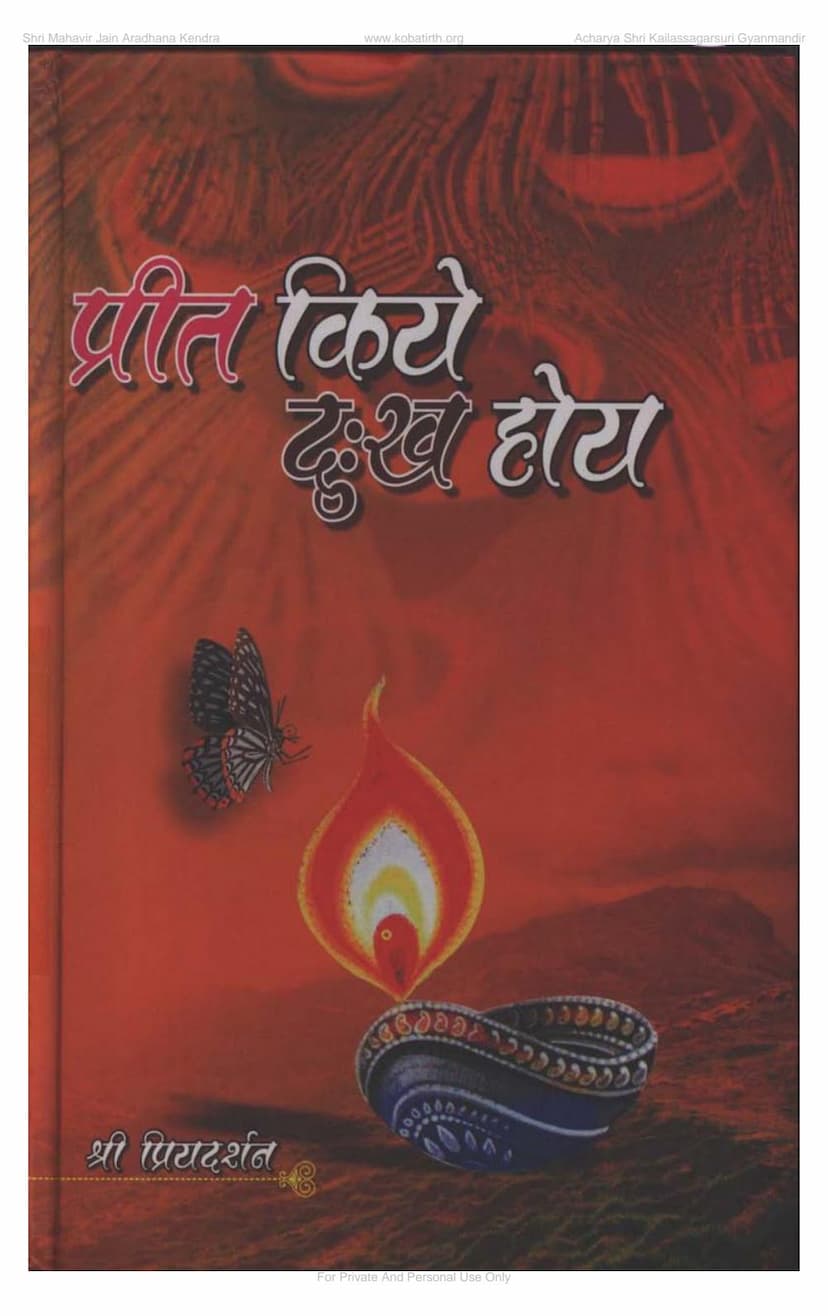Prit Kiye Dukh Hoy
Added to library: September 2, 2025

Summary
Here's a comprehensive summary of the Jain text "Prit Kiye Dukh Hoy" (प्रीत किये दुःख होय) by Acharya Shri Vijaybhadraguptasuri, based on the provided text:
Title: Prit Kiye Dukh Hoy (प्रीत किये दुःख होय) - Meaning "Love leads to sorrow" or "Attachment brings suffering."
Author: Acharya Shri Vijaybhadraguptasuri (also referred to as Shri Priyadarshan)
Publisher: Shri Mahavir Jain Aradhana Kendra, Koba, Gujarat, India.
Core Theme: The book is presented as a "dirgh katha" (long story) that primarily aims to illustrate the profound and ineffable power of the Shri Namaskar Mahamantra (the five-line Jain mantra, "Namo Arihantanam," etc.).
Narrative Structure: The text narrates the life story of SurSundari, a princess, and her friend Amar, who later becomes her husband, Amar Kumar. The story is rich with moral lessons, philosophical insights, and emphasizes the transformative power of faith and devotion, particularly towards the Namaskar Mahamantra.
Key Characters and Plot Points:
- SurSundari: A virtuous and intelligent princess who, despite her royal upbringing and education in sixty-four arts, develops a deep spiritual inclination. She learns the importance of the Namaskar Mahamantra from Sadhvi Suvrata and strives to live a life guided by Jain principles. Her journey is marked by trials, betrayals, and ultimately, her unwavering adherence to righteousness and devotion.
- Amar Kumar: A talented and intelligent son of a wealthy merchant. He initially falls out with SurSundari over a minor incident involving seven cowries but later rekindles their friendship and love. He proves to be a virtuous and capable individual, eventually marrying SurSundari. He is later revealed to be the disguised VimalYash, and ultimately, Amar Muni.
- The Namaskar Mahamantra: The central pillar of the narrative. The story repeatedly highlights how reciting, remembering, and internalizing the teachings of this mantra protects individuals from harm, brings about spiritual progress, and leads to liberation. It's shown to have the power to overcome even supernatural threats like Yakshas and the ill intentions of wicked individuals.
- A Series of Ordeals: SurSundari faces numerous challenges:
- Amar's Initial Anger: An early conflict with Amar over the seven cowries, which tests their friendship.
- The Yaksheadya Island: Abandoned by Amar (under the influence of vengeance due to a childhood misunderstanding), she faces a dangerous Yaksheadya island and the threat of a man-eating Yaksha. Her devotion to the Namaskar Mahamantra protects her, and the Yaksha, transformed by her piety and the mantra's power, becomes a benevolent protector.
- The Merchant Dhananjay: An unscrupulous merchant attempts to take advantage of her beauty and vulnerability, but her steadfastness and the mantra's protection foil his plans.
- The Merchant Fanhan: Another deceitful merchant tries to capture her, but her integrity and the mantra's power again lead to his downfall in a sea storm.
- The Criminal "Chor" (Amarnath/VimalYash): She encounters a cunning thief who operates under various disguises. This thief, through a series of elaborate deceptions, manages to fool many, including the King himself, and is eventually brought to justice by the wisdom and insight gained through spiritual practices.
- The King of SumanGita, RatnaJati: A kind and virtuous Vidyadhar king who rescues SurSundari and treats her like a beloved sister, providing her with spiritual guidance and protection. He is deeply influenced by her devotion.
- The King of Benataṭ, Gunpal: Another ruler who is impressed by SurSundari's character and beauty.
- Amar's Transformation: Amar Kumar also embarks on a journey of self-discovery and spiritual growth, influenced by SurSundari and the teachings of Jainism. He faces his own challenges and learns about the consequences of his actions, eventually dedicating himself to righteous living.
- The Union and Renunciation: Ultimately, SurSundari and Amar Kumar, after overcoming immense difficulties, achieve a state of spiritual realization. They, along with their families, eventually renounce worldly pleasures and embrace the path of asceticism (sanyam marg), ultimately attaining liberation (moksha).
Key Teachings and Messages:
- The Supremacy of the Namaskar Mahamantra: The story consistently demonstrates the mantra's efficacy in protecting devotees, resolving crises, and leading them towards spiritual liberation. It is portrayed as a shield against all advers and a source of immense spiritual power.
- The Law of Karma: The narrative underscores the Jain principle that actions (karma) have consequences. SurSundari's past actions, both positive and negative, shape her present circumstances, and her devotion helps her navigate the results of her karma.
- The Importance of Shila (Chastity/Integrity): SurSundari's unwavering commitment to her integrity and chastity is her ultimate strength, protecting her from dire situations and earning her respect and divine intervention.
- The Value of Spiritual Knowledge: The teachings of gurus and saints, particularly regarding the Namaskar Mahamantra, are crucial for SurSundari's spiritual journey and survival.
- The Superficiality of External Beauty vs. Inner Purity: While SurSundari is described as beautiful, her true strength lies in her inner purity, devotion, and integrity, which ultimately triumph over superficial allure and wicked intentions.
- The Power of Faith and Devotion: SurSundari's unwavering faith in the Namaskar Mahamantra and her devotion to Jain principles are her constant guides and protectors.
- The Ideal of Renunciation: The ultimate goal for SurSundari and Amar Kumar is to detach from worldly possessions and pursue spiritual liberation, demonstrating the Jain ideal of renouncing worldly attachments for the sake of the soul's ultimate freedom.
- The Nature of Love and Attachment: The title itself, "Prit Kiye Dukh Hoy," suggests a nuanced exploration of love. While pure and spiritual love is encouraged, worldly attachments and infatuations are portrayed as leading to suffering.
Overall: "Prit Kiye Dukh Hoy" is a devotional and didactic Jain narrative that uses a compelling story of SurSundari's life to deeply impress upon the reader the spiritual significance and practical power of the Namaskar Mahamantra, while also illustrating fundamental Jain philosophical concepts like karma, shila, and the ultimate path to liberation.